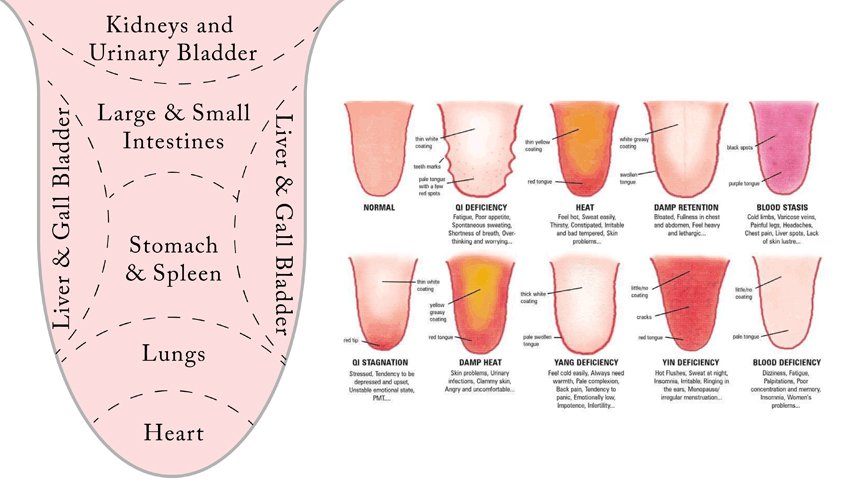Tongue Diagnosis
Acupuncture & Chinese Medicine treatment involves a detailed inspection of the patient’s tongue to obtain diagnostic information about the current condition of the internal organs and related systems. When I ask patients if I can take a look at their tongue many patients that are new to Acupuncture & Chinese Medicine find this request a bit odd. However, they are always good about it and remain open-minded and pleasantly put their tongue on display. Without fail their hesitation turns into curiosity and they must know “What do you see? What are you looking for? Why does it look that way”
An Acupuncture & Chinese medical view of the tongue
In Acupuncture & Chinese Medicine the tongue is divided into five different areas. Each area represents the current state of health of its designated organ and organ system.
The first area is the front portion of the tongue, which is related to the organs of the chest - the Heart and Lungs.
The second area is the tongue centre, representing the health of the Spleen & Stomach, which equates to the digestive system in Western Medicine.
The third & fourth areas are the sides of the tongue, which pertain to the state of the Liver on the left and the Gall Bladder on the right.
The fifth area the rear of the tongue shows the current health of the Kidneys, Bladder, and Intestines.

What are we looking for?
When we inspect a patient’s tongue we are assessing 6 things:
1. The overall colour(s) of the tongue body
2. The shape and size of the tongue body
3. The thickness and distribution of the tongue coating
4. The colour of the tongue coating
5. The moisture of the tongue
6. The appearance and colour of papules on tongue body
The appearance of the tongue is constantly in flux, changes often depend on a number of factors such as: types of foods eaten that day, quality and amount of sleep, emotional state, current health conditions, and the time of the month for women. A person in good health should exhibit a tongue that is supple with a slightly moist pale red body and a thin white coating. Changes in health may reflect in the tongue. For example, a person suffering from adrenal fatigue with insomnia may present with a tongue that has a peeled or absent coat, a red dry tongue body and a very red tongue tip. While a person with irritable bowel syndrome (IBS) may have a tongue that is quite pink and pale, with tooth mark indentations along the side borders of the tongue and a thin to thick white or yellow coating.
Your tongue
So what does your tongue look like? I have a challenge for you. Compare your tongue before and after a night at the pub or a night of fish and chips. You might be surprised at the changes that you see.
Call us today to book a FREE 15 minute initial consult.
References:
Maciocia, Giovanni, Tongue Diagnosis in Chinese Medicine (Eastland Press, 7th Ed, 2004)
Learn
What to expect from your therapy or treatment.
About
Learn about our practitioners' extensive experience.
FAQs
Answers to most frequently asked questions.

Introductory Offer for New Patients
Call (02) 5590 0232 to book your FREE 15 minute assessment.



